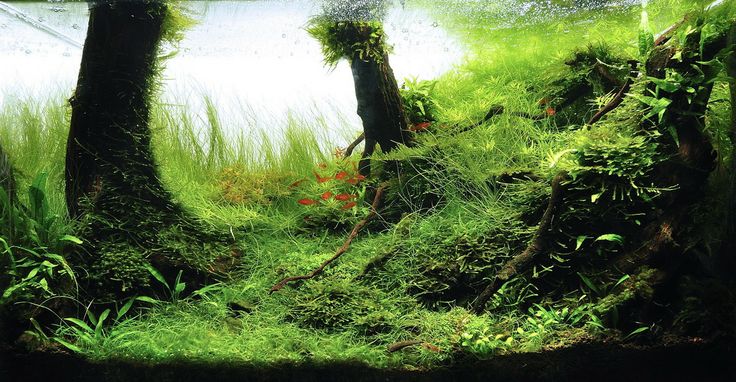
Welcome to this invigorating rundown of the top ten beloved aquarium live plants that are the unsung heroes of the subaquatic realm! Let’s immerse ourselves in an in-depth exploration of these remarkable flora species.
From the multifunctional Java Moss to the graceful Cabomba Caroliniana, we’ll unravel the hidden narratives of these water wonders. We’ll scrutinize their advantages, weigh their disadvantages, and give you firsthand accounts with real customer reviews. So, get ready to dive into the vibrant universe of aquarium live plants!
Java Moss
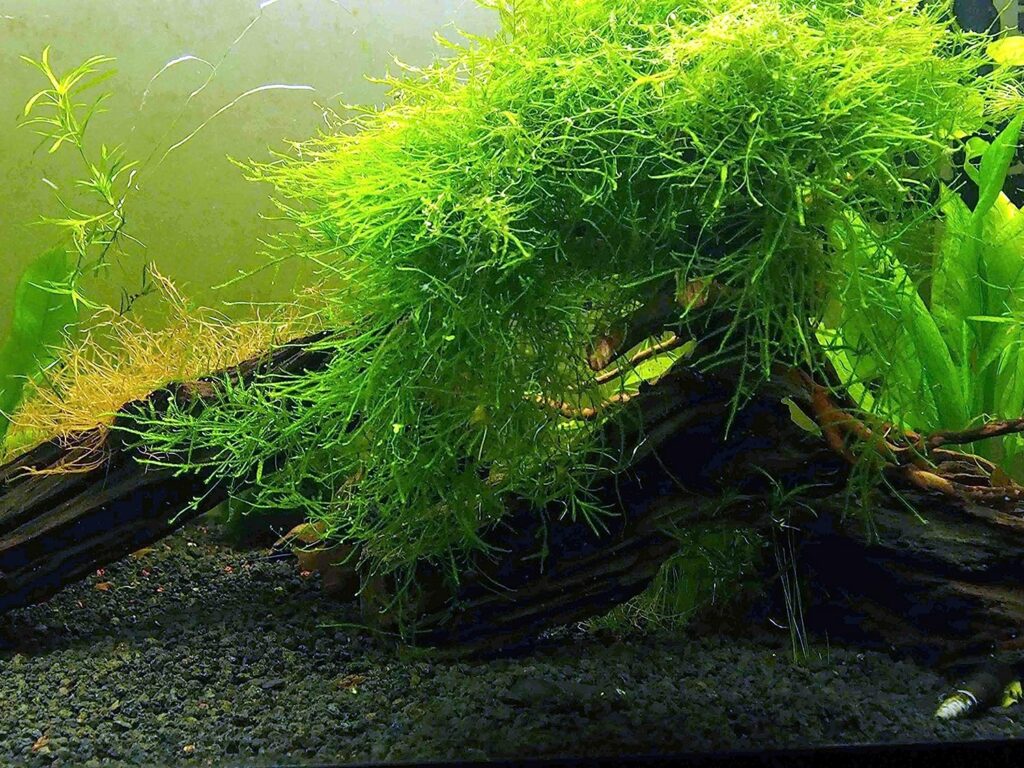
Say hello to Java Moss, the perfect starter plant for any aquarium enthusiast. This hardy little plant hails from Southeast Asia and it’s a popular choice in the aquatic world. Its vibrant green hue completes the picturesque scene in any fish tank.
Pros:
Ever thought of impressing your friends with flourishing aquatic greenery? Well, with Java Moss, consider it done! It’s easy to grow even for the most forgetful plant owners. And it’s not just pretty – it guards against excessive algae and provides a great spot for tiny fish to hang out.
Cons:
But hey, without a small drama, life would be dull, wouldn’t it? Java Moss might grow a little too well. Maintain a keen eye to prevent it from turning your aquarium into its green empire!
Customer Reviews
Customers seem to agree with us on the allure of Java Moss. They rave about its ease of planting and maintenance. A couple of reviews mention the challenge of controlling its growth but in the end, it brings a dash of green goodness to their aquarium.
Hold your horses, though! Or rather, your aquatic plants. Up next is another contender for your attention – Anubias Barteri. We bet you’re as excited as we are!
Anubias Barteri
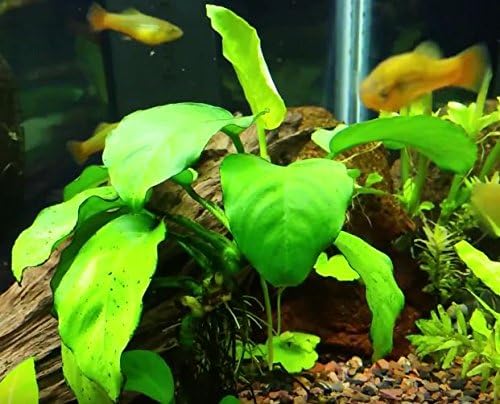
Let’s dive right in. Anubias Barteri, often known as the “aquatic tough guy,” is the sturdy, long-living plant you need for your aquarium. The secret weapon? It has rubbery, dark green leaves that stubbornly stand their ground, even in low light conditions.
Pros:
Here’s why you’ll love this aquatic Rambo. First, it’s super easy to care for – perfect for beginners. Second, it provides a well-appreciated hiding spot for your shy fish. Finally, it’s eye-catching. One look at its dark green glory will have you saying, “Tank you very much!”
Cons:
But Anubias, like anything in life, is not perfect. A common issue is algae growth on the leaves. Also, it’s slow-growing. So, if you’re aiming for a plant-infested-Atlantis look in a week, this might not be your cup of tea.
Customer Reviews
Wondering what the fish enthusiasts say? Well, reviews are generally positive. They love its resilience, aesthetic appeal, and how it provides a cozy corner for their fin-clad friends. However, a few grumblings about slow growth and the occasional algae issue do float around.
Now, let’s wave goodbye to Anubias Barteri and dip our toes into the fascinating world of our next aquatic superstar – the Amazon Sword. Get ready to explore another leafy wonder of the watery world.
Amazon Sword (Echinodorus grisebachii)

Say hello to the Amazon Sword, the Arnold Schwarzenegger of the aquarium world. Known for being strong, sturdy, and showing off, this plant likes to be the center of attention in your aquatic Eden. Coming from South America jungle streams, it thrives in aquariums, with its robust leaves offering a vibrant splash of green.
Pros:
Perfect for green-thumbed beginners, Amazon Sword isn’t a fussy roommate. It demands low light and simple substrate. No need to worry about tank overcrowding; this plant’s tall and wide leaf layout offers a scenic cover for your swimming friends without being invasive. And yes, it is pretty hard to kill, making it a real hang-in-there buddy.
Cons:
Now, even action stars have their weak spots. Amazon Swords require regular nutrients to maintain their lush Green-Oaks look. Also, beware, it grows faster than you think. If left unattended, it might just rule your aquarium. Yes, it goes full ‘Jumanji’ on you!
Customer Reviews
Our aquarium-family reviewers love the Amazon Sword for its drama-free nature, and vibrant appearance. Though some grumbled about playing ‘Jack’s beanstalk control’, the charisma of this plant made it a rewarding experience. It’s got a five-star fish approval rating, favorited for offering hide-n-seek spots for aquatic pets.
On an interesting note, few fish-parents mentioned, “It turned my tank into an underwater haven.”
Now that we’ve covered the mighty Amazon Sword, let’s switch gears and dive into the marvel of Cryptocoryne Wendtii. Stay tuned to make your aquarium plant-savvy.
Cryptocoryne Wendtii
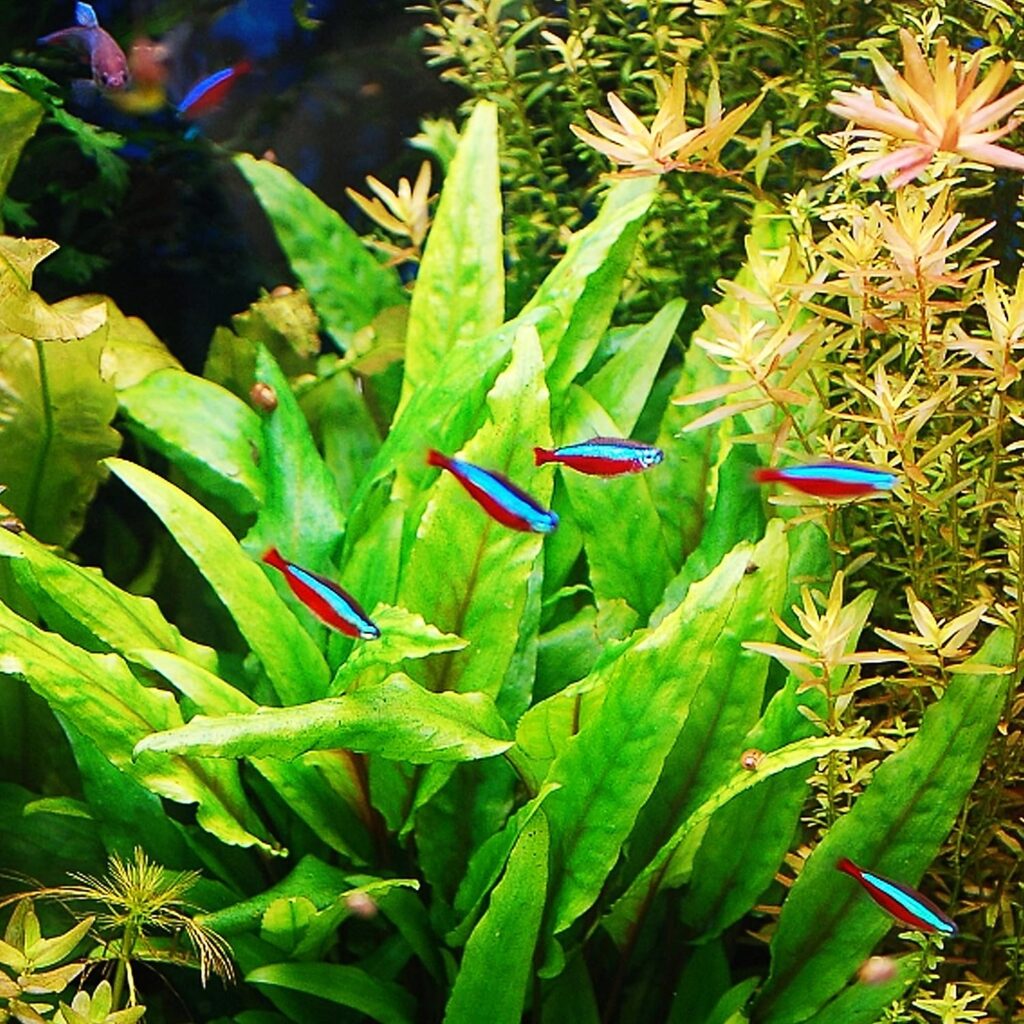
Meet the Cryptocoryne Wendtii. In the world of aquatic plants, it’s a rockstar. This water-loving green beauty is native to Sri Lanka. Wendtii plants rule the roost in the Aqua Land for their low maintenance nature. They grace the foreground, middle ground, or background of an aquarium thanks to their varied sizes. Good looker, isn’t it?
Pros:
Got rough water or a low-light aquarium? No sweat! Wendtii is a tough cookie. It can endure diverse water conditions and thrive in low light. On top of that, it’s not finicky about the substrate. Gravel, sand, soil or peat? Wendtii says bring it on! All these qualities make it a lovely pick for both beginners and seasoned aquarists.
Cons:
Like everything under the sun, Wendtii isn’t perfect. The hitch? It’s a slow grower. For aquarists craving instant lushness, it’s a bit of a challenge. And although it can thrive in harsh conditions, it does appreciate occasional doses of CO2 and nutrients. Just don’t over pamper it!
Customer Reviews
Alright, let’s get some real talk from users. It seems the customers are smitten. They adore its hardiness and ability to adapt. The slow growth has been a downer for a few. But the overall verdict? It’s an aquarium charm that’s not to be missed.
To wrap up, Cryptocoryne Wendtii is like that favorite comfy sweater. Reliable, cozy, and always there when you need it. Now, are you ready to dive into another realm of aquatic greenery? Say hello to the Dwarf Hairgrass. Coming up next.
Dwarf Hairgrass
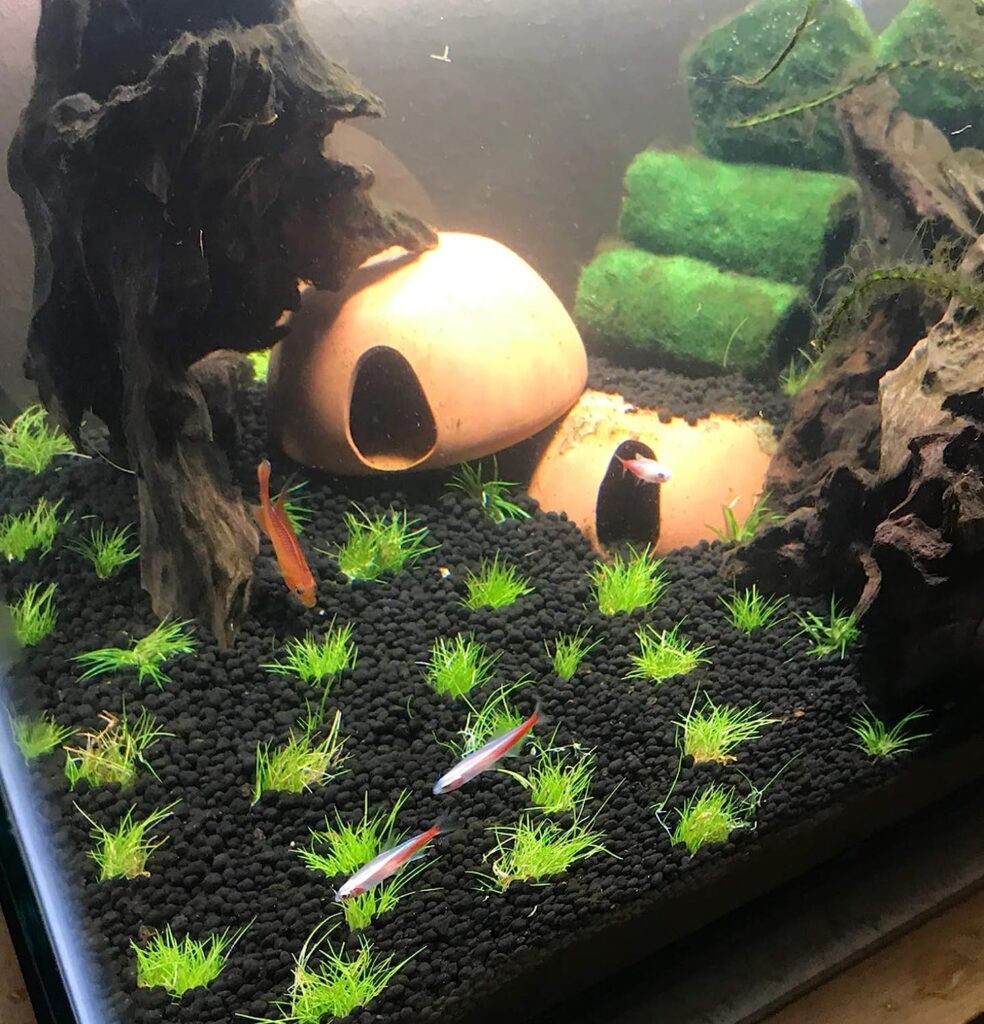
Imagine summer breezes stroking across meadows, making the grass sway. That scene? It can sway right in your aquarium! Enter the Dwarf Hairgrass – a freshwater plant that thrives underwater. Its tiny, thread-like leaves grow vertically, giving it its characteristic ‘grassy’ look. It’s like a tiny piece of prairie within your tank. Peaceful, eh?
Pros:
The short grassy dwarf brings some perks. For one, it creates a soft, green underwater carpet. Fish and critters just love to play hide-n-seek in this lush turf-like playground. Secondly, it’s low-maintenance. Just provide it with some good light and CO2, and it’ll dance its way to happiness.
Cons:
But life is all about balance, ain’t it? There are downsides to the Dwarf Hairgrass. Eager little critters can easily uproot it. And like a moody teenager, it demands good light and CO2. Oh, and it grows slowly, inching its way to spread.
Customer Reviews
Going by the online chatter, this aqua prairie seems to have won hearts. One customer called it the “amazing underwater magic carpet.” Some applauded how it adds depth and texture to the aquariums. But there were also whispers about low growth rates and high light demands. So, it’s got a mixed bag of love and grumbles.
Watch out, aquarium lovers! Coming up next is a plant that’s not just a plant – it’s a bit of a celebrity. It’s loved, it’s talked about, it has fan clubs on aquarium forums. Can you guess it? Stay tuned, we’re diving into all that’s there to know about it in the next section.
Marimo Moss Balls
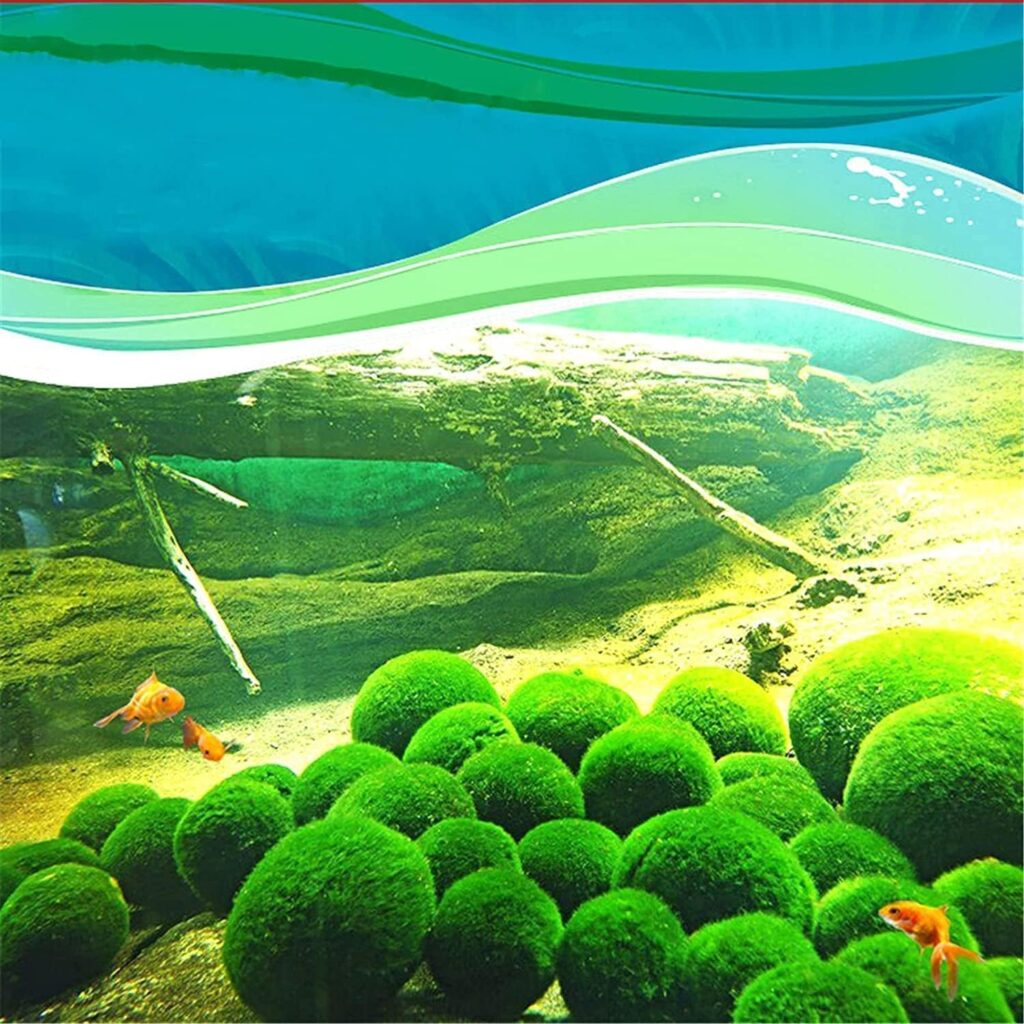
Let’s dive under the water, all the way to Japan. If we peek into their luscious lakes, we’d find Marimo Moss Balls. While they sound like a delicious sushi roll, they’re actually perfectly round algae. Fancy, right? They’re not just a hit with Instagram influencers. Aquarium enthusiasts love them too because of their aesthetic appeal and easy maintenance.
Pros:
These little green darlings are the low-maintenance pets of the plant world. They don’t need much light, which is perfect for our water-dwelling friends who like the darker side of life. Plus, they suck up nitrates like tiny, mossy vacuum cleaners, cleaning up your tank in a jiffy.
Cons:
But, behind their cute facade, there’s a bit of a dark side to our Marimos. They’re slow growers, which might not satisfy your inner green-thumbed beast. Plus, while they are technically algae, Marimos can occasionally play host to other, less-friendly forms of algae. It’s like a sitcom where the main characters don’t get along. Hilarious, but not entirely ideal.
Customer Reviews
The people’s verdict? They love these little balls of joy. Many reviews rave about the low maintenance and the kids’ fascination with these slow-moving, green globes. However, a few grumbles focus on that inconvenient algae invasion we mentioned earlier.
We’ve found tranquility in the spherical simplicity of the Marimo Moss Balls. Now, we’re going to shake things up a bit. Our next stop is the octopus-like Water Wisteria. Ready for a bit more complexity? Read on, brave explorer!
Water Wisteria (Hygrophila Difformis)

Imagine a forest of underwater trees that sway gracefully with the tides. That’s the enchanting beauty that Water Wisteria brings to your aquarium! This plant boasts odd-shaped leaves that form a distinct, attractive pattern. Don’t worry about maintenance, because just like the other plants we’ve tackled, Water Wisteria doesn’t demand much.
Pros:
Firstly, think of Water Wisteria as a snack shop for your fish. Its lush leaves offer an excellent grazing area. Plus bonus, it’s a fantastic oxygen producer and a nifty home for spawning fish. Its fast growth can also help keep those pesky algae in check.
Cons:
Now for the cons. While Water Wisteria doesn’t demand a high-falutin’ lifestyle, it does need a fair bit of light to flourish. We wouldn’t call it a diva but, well, that’s a tad diva-ish. And because of its rapid growth, you might be stuck playing gardener more often than you’d like due to its pruning demands.
Customer Reviews
Our fishkeeping friends adore Water Wisteria, primarily praising its robustness and growth rate. Some users do comment on its diva-like light demands, but they say it’s all worthwhile once you see the underwater forest it creates.
We’ve taken a dip with Water Wisteria, now let’s surface to get some air and meet the Java Fern, another green wonder of the aquatic world! You’ll see why it’s another top pick among aquarists, and we might even crack a fern pun or two along the way (you’ve been warned). So, brace yourselves and let’s dive back down.
Java Fern (Leptochilus Pteropus)
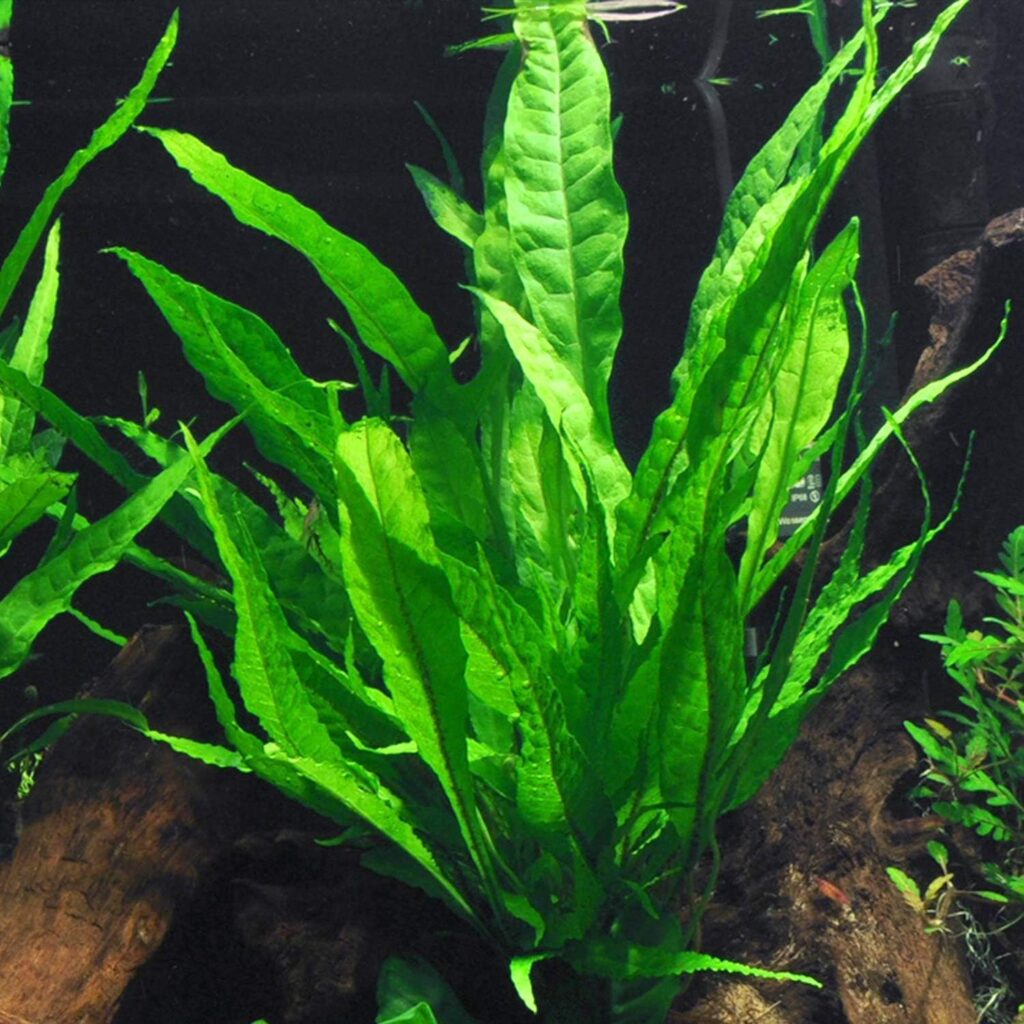
Get ready to be wowed by the world of aquatic plants! One such star is the Java Fern. A classic favorite among aquarium hobbyists, this plant is the embodiment of “low maintenance, high reward”. With its bushy lush green leaves, it adds a vibrant touch to your aquatic paradise.
Pros:
No green fingers? No problem! Java Fern just asks for low light and minor TLC. It’s the best candidate for that “I just randomly threw some plants in and voilà, an underwater garden!” look.
Plus, I think the fishes would appreciate the captivating hide-and-seek spots it provides, don’t you?
Cons:
But hey, much like that moody artist friend we all have, it sometimes won’t anchor properly and floats around. Not just that, new hobbyists may struggle with brown spots on leaves due to stress or adjustments.
Customer Reviews
Truth or dare, customer-review edition: customers seem smitten by the constant stream of new leaves. And hey, even the occasional brown spot crisis hasn’t stopped the 5-star ratings from rolling in.
Brace yourself! We’re taking another deep dive, this time into the vibrant world of Ludwigia Repens. Buckle up, Aquachums! It’s going to be a wet and wild ride!
Ludwigia Repens
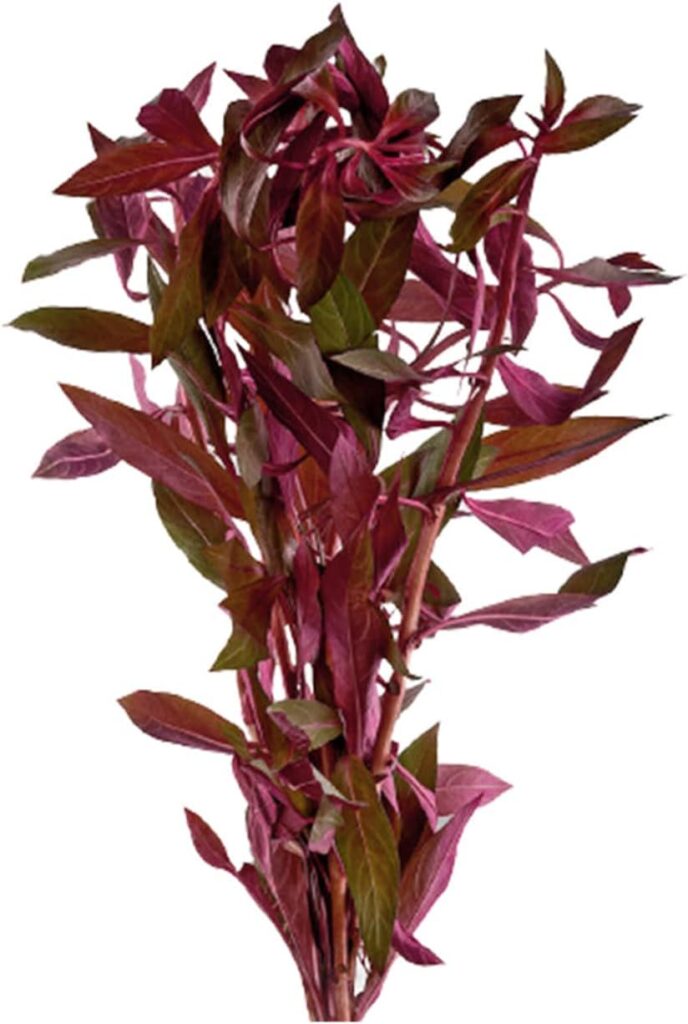
Ludwigia Repens! Quite the mouthful, isn’t it? But don’t let its posh name scare you. This is simply a vibrant addition to any aquarium. Originating from the hot and steamy lands of North America, it’s a fast-growing plant. Ever fancied a hint of red in your water-home? Ludwigia Repens gives that swanky pop of color, making your fish feel like they are at a year-long Christmas party!
Pros:
Who doesn’t love a quick fix? Ludwigia Repens is a rapid grower, ideal for impatient green thumbs. Plus, guess what? It’s low maintenance too! No green thumb required. Lastly, it’s the drama queen of aquatic plants. Its flamboyant red leaves are a real showstopper, adding a burst of pizzazz to your tank.
Cons:
Every rose has its thorn, right? With Ludwigia Repens, it’s the lighting it demands. It craves a stronger light to show off its lovely red hue. Faint-hearted light may leave it looking less red carpet worthy and more washed out. And while it’s not too picky about water conditions, it does require proper nutrients to maintain its growth.
Customer Reviews
Customers rave about Ludwigia Repens, heading their reviews with big, capital letters: “AWESOME COLOR!” Many have lauded its rapid growth rate and low maintenance care. However, a few have grumbled about it losing its vibrant color under poor lighting. The verdict? Get the lighting right, and you’ve got a paparazzi-worthy plant!
And that’s all about Ludwigia Repens folks! Let’s dive into the next one, Green Cabomba. Another mouthful but another beauty waiting to grace your aquarium. Stay tuned!
Cabomba Caroliniana

Let’s spotlight our final actor, the Green Cabomba – the Brad Pitt of aquarium plants. With long, flowy strands resembling the mane of a Hollywood superstar, they’ll turn any aquarium into an underwater red carpet.
Pros:
Here’s the upside: Green Cabomba is a cinch to grow. It’s like a green thumbs-up for those of us still haunted by that grade school bean sprout experiment (you know the one). Plus, its fab green color is more refreshing than a mint mojito on a summer day.
Cons:
Now, the gossip column: Green Cabomba has a diva streak. It demands bright lights. Dimly lit situations do not flatter it. Also, it’s not one for solitary confinement – it looks its best in a crowd.
Customer Reviews
Like fans gushing about their idol’s newest flick, customers rave about Green Cabomba’s lush look. Also, our fans – I mean customers – love its forgiving nature. A few, however, have mentioned it does have its difficult, demanding sides.
To Sum Up
With the end of our top 10 list, we’ve rolled the credits on our aquatic greenery stars. So, after learning about these purveyors of underwater glamour, which one will find a place in your aquarium oasis? Will it be the low-maintenance Java Moss? The elegant Anubias Barteri? Or perhaps, the Green Cabomba superstar? The decision is yours, dear reader.
In the booming world of aquascaping, you’ve myriad aquatic plants to choose from. From the hearty Java Moss to hard-to-kill Anubias Barteri, and the delicate Amazon Sword to Cryptocoryne Wendtii, each offers unique advantages and drawbacks.
Consider opinions from other green thumbs like yours. Customer reviews promote the lush Dwarf Hairgrass and the magically rolling Marimo Moss Balls. They also point out the fast-growing Water Wisteria, easy-maintenance Java Fern, vibrant Ludwigia Repens, and the light-loving Cabomba Caroliniana. Each plant will bring your underwater world to life in its unique way. Enjoy making your own little watery paradise.
Frequently Asked Questions (FAQ)
Question: What are the benefits of having live plants in my aquarium?
Answer: Live plants help to balance the aquarium environment. They absorb carbon dioxide, produce oxygen, offer hiding places for fish, and contribute to the aesthetic appeal of the tank.
Question: How do I care for Java Moss in my aquarium?
Answer: Java Moss is simple to care for. It requires low to moderate light and prefers slightly acidic water. No additional CO2 is necessary, making it perfect for beginner aquarists.
Question: Is Anubias Barteri suitable for all types of aquariums?
Answer: Yes, Anubias Barteri is one of the most adaptable aquarium plants. It can thrive in a wide range of water parameters and light levels, making it perfect for any aquarium type.
Question: Is Dwarf Hairgrass easy to maintain?
Answer: Dwarf Hairgrass is relatively easy to care for but it needs proper lighting and nutrients to grow properly. It’s preferred by many because it creates a luxurious green carpet effect in the tank.
Question: Why is Marimo Moss Balls a popular choice for aquarium set-ups?
Answer: Marimo Moss Balls are popular for their unique appearance and low maintenance requirements. They absorb harmful nitrates, provide oxygen, and are known to bring good luck!
Question: How often should I trim Water Wisteria?
Answer: Water Wisteria is a fast-growing plant that may need to be trimmed regularly. Typically, every 1 to 2 weeks is sufficient to keep it in control.
Question: What’s special about the Cabomba Caroliniana?
Answer: Cabomba Caroliniana, also known as Fanwort, is known for its attractive, feather-like foliage that provides nice hiding spots for fish and adds a lush, natural look to the aquarium.
Question: I have a goldfish, I’m wondering what kind of plants can I use in my goldfish aquarium?
Answer: Great choice! You can definitely enhance your goldfish aquarium with various kinds of plants. Generally, goldfish do well with sturdy, fast-growing plants like Anubias, Java Ferns, and Hornwort. However, remember that goldfish are notorious for being a bit rough with plants, so choose ones that can withstand their activity. To get a more detailed list of suitable plants, I recommend checking out this article 10 Best Live Plants for a Goldfish Aquarium. It will guide you to choose the best plants for your goldfish environment.
